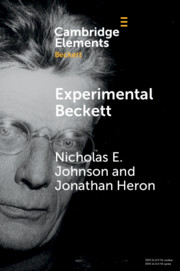Element contents
Experimental Beckett
Published online by Cambridge University Press: 28 March 2020
Summary
- Type
- Element
- Information
- Series: Elements in Beckett StudiesOnline ISBN: 9781108767750Publisher: Cambridge University PressPrint publication: 30 April 2020
References
- 15
- Cited by

